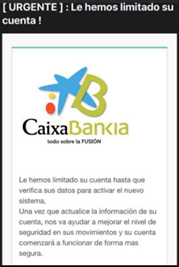Cybercriminals know that users are most vulnerable to their attacks during times of change and transformation. With the onset of the global pandemic, for example, they took advantage of the fear caused by the public health emergency, and used the coronavirus as bait for their cyberattacks.
With the merger between CaixaBank and Bankia, the millions of customers must be more alert than ever to possible scams targeting them, since there are an increasing amount of attacks that impersonate CaixaBank and Bankia.
The messages used by cybercriminals are evolving, as they tailor them to the current merger process and to customers' day-to-day lives. The transition from Bankia's old online banking system to the CaixaBankNow app is now the main bait for their scam messages.

